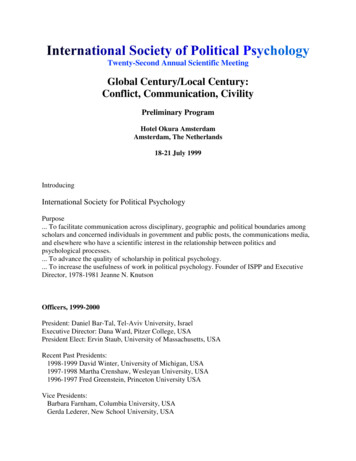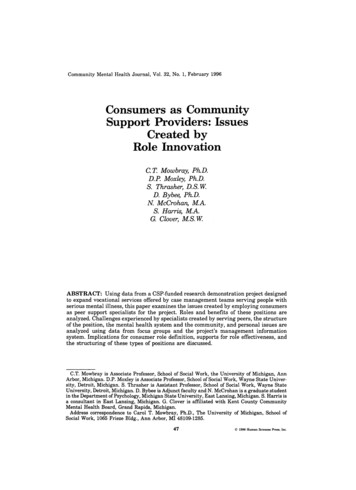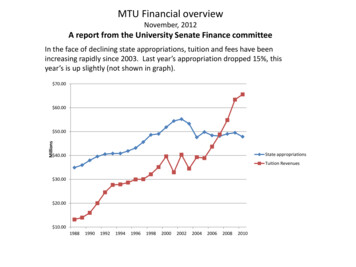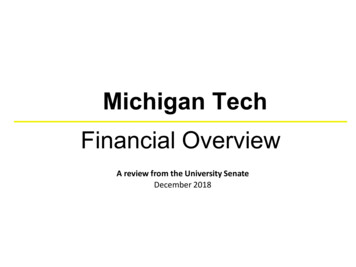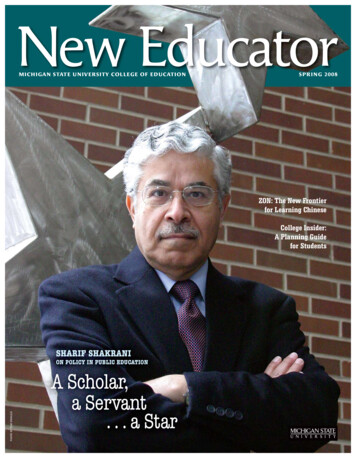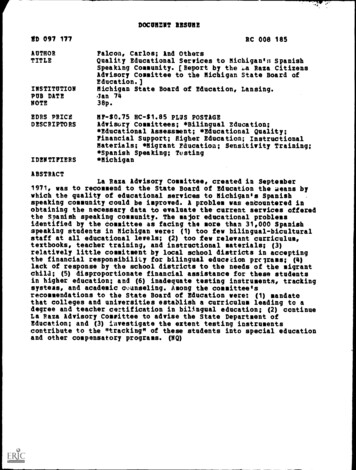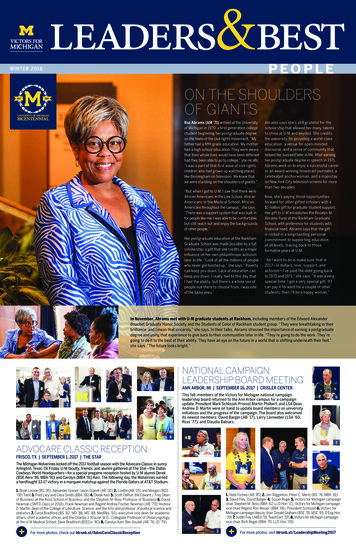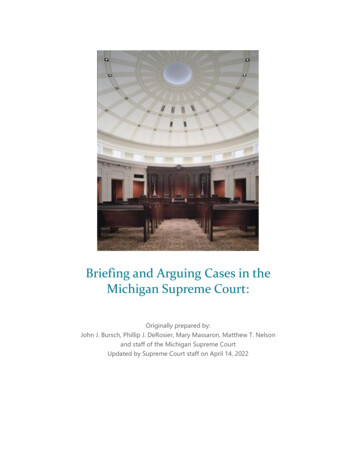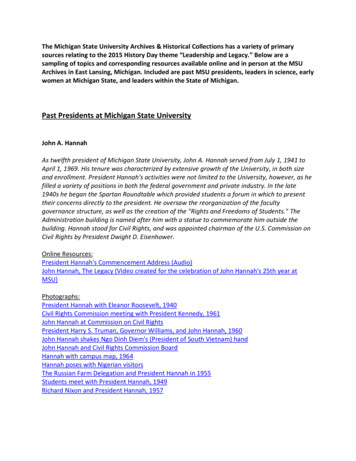
Transcription
The Michigan State University Archives & Historical Collections has a variety of primarysources relating to the 2015 History Day theme “Leadership and Legacy.” Below are asampling of topics and corresponding resources available online and in person at the MSUArchives in East Lansing, Michigan. Included are past MSU presidents, leaders in science, earlywomen at Michigan State, and leaders within the State of Michigan.Past Presidents at Michigan State UniversityJohn A. HannahAs twelfth president of Michigan State University, John A. Hannah served from July 1, 1941 toApril 1, 1969. His tenure was characterized by extensive growth of the University, in both sizeand enrollment. President Hannah's activities were not limited to the University, however, as hefilled a variety of positions in both the federal government and private industry. In the late1940s he began the Spartan Roundtable which provided students a forum in which to presenttheir concerns directly to the president. He oversaw the reorganization of the facultygovernance structure, as well as the creation of the "Rights and Freedoms of Students." TheAdministration building is named after him with a statue to commemorate him outside thebuilding. Hannah stood for Civil Rights, and was appointed chairman of the U.S. Commission onCivil Rights by President Dwight D. Eisenhower.Online Resources:President Hannah's Commencement Address (Audio)John Hannah, The Legacy (Video created for the celebration of John Hannah's 25th year atMSU)Photographs:President Hannah with Eleanor Roosevelt, 1940Civil Rights Commission meeting with President Kennedy, 1961John Hannah at Commission on Civil RightsPresident Harry S. Truman, Governor Williams, and John Hannah, 1960John Hannah shakes Ngo Dinh Diem's (President of South Vietnam) handJohn Hannah and Civil Rights Commission BoardHannah with campus map, 1964Hannah poses with Nigerian visitorsThe Russian Farm Delegation and President Hannah in 1955Students meet with President Hannah, 1949Richard Nixon and President Hannah, 1957
Resources at the MSU Archives:Hannah Speeches 1946-1951 – Reading Room (Shelf D)John A. Hannah Papers (UA.2.1.12)John A. Hannah by Richard Niehoff, 1989 – Reading Room (Shelf D)A Memoir by John A. Hannah, 1980 – Reading Room (Shelf D)MSU Information Files - Presidents. Hannah, John A.Media Communications Records (UA 8.1.1)Biographical Files. Hannah, John. A. (Box 2711)Dr. Clifton R. Wharton, Jr.Dr. Clifton R. Wharton, Jr, 14th president of MSU, was the first African-American to serve aspresident of any major university in the United States. His term in office was often turbulent,featuring student demonstrations in 1970 and 1972, and a National Collegiate AthleticAssociation investigation of the MSU football program. Wharton’s major achievements were hissuccessful efforts to maintain the quality of MSU's academic programs despite budgetreductions, his commitment to the education of the economically and educationallydisadvantaged, and the integration of the College of Osteopathic Medicine with the othermedical schools. Major innovations implemented under Wharton's tenure included thePresidential Commission on Admissions and Student Body Composition to study futureenrollment policies and a Presidential Fellows Program to allow selected students and juniorfaculty members to gain experience in university administration. Wharton's most lastingcontribution to the University was a new center for the performing arts. The building, dedicatedin 1982, was named in honor of Wharton and his wife Dolores, in recognition of the strongsupport, which they gave the project. Wharton resigned from Michigan State University inDecember 1977 to accept the Chancellorship of the State University of New York.Online Resources:Trial & Triumph: The Wharton Years 1970-1978. A tribute to Clifton R. Wharton, Jr. & DoloresWharton"Visit with Wharton" News BulletinPhotographs:Clifton Wharton with John Hannah, 1969Clifton Wharton with Family, 1969Clifton Wharton in the classroom, 1973Clifton Wharton at his first press conference, 1969Materials at the MSU Archives:Clifton R. Wharton, Jr. papers (UA 2.1.14)Thomas H. Greer papers (UA.17.21)People. Wharton, Clifton. Newspaper clippings 1969-1975 (Box 2907, Folder 53)People. Wharton, Clifton 1971-1977 (Box 2907, Folder 54)
Vice President for Student Affairs Student Protest files (UA.7.0)"Wharton's year: a little of everything" MSU Faculty News, January 5, 1971 (Box 1050H,Folder 24)MSU Information Files - Presidents. Wharton, Clifton Jr.Media Communications Records (UA 8.1.1)Biographical Files. Wharton, Clifton R. (Box 2714)Science at Michigan State University:Barnett Rosenberg"Barnett Rosenberg was a scholar interested in many areas of science but is best known for hisdiscovery of cisplatin, a platinum compound with anti-cancer properties. The initial discoveryoccurred in 1965 when Rosenberg and Loretta Van Camp subjected E. coli to an electric fieldcreated from electrodes coated with the metal platinum. The electric field caused the E. coli. togrow into long strands instead of dividing normally. Further research by Thomas Krigas andAndrew Thompson led to the understanding that the strands were caused by the use of theplatinum on the electrodes. With cancer research in mind, Rosenberg then began research intothe effects of the platinum electric fields on various chemicals. He eventually found the idealcompound and called it cisplatin. Rosenberg and the members of his lab then began researchingthe use of cisplatin on cells in cancerous tumors and in 1968 they confirmed that it could inhibitcancer cells. In 1971 cisplatin was used in clinical trials in humans. The drug cisplatin wasapproved for use by the FDA in 1978. Later Rosenberg and James Hoeschele began experimentswith carboplatin, another platinum compound. It too was also used to treat cancer." (On theBanks of the Red Cedar website)Online Resources:Exhibit - Barnett Rosenberg (On the ws and Comments Newsletter, January-March 1971Sesquicentennial Oral History Project Barnett RosenbergPhotographs:A chart showing the cure rates of leukemia in rats using cisplatinBarnett Rosenberg and Loretta Van Camp with photographs of normal bacteria and bacteriathat have been treated with platinumEquipment used by Barnett Rosenberg, 1965Portrait of Barnett Rosenberg, 1971
Materials at the MSU Archives:Barnett Rosenberg papers (UA 17.289)MSU Information Files – People. Rosenberg, BarnettMedia Communications Records (UA 8.1.1)Biographical Files. Rosenberg, Barnett. (Box 2688, Folder 100)Lyman BriggsIn 1889, at the age of 15, Lyman Briggs entered Michigan Agricultural College where he wouldgraduate with a degree in Agriculture in 1893. He went on to receive a M.S. in physics at theUniversity of Michigan and a P.H.D. at John Hopkins University. In 1896, Briggs married hiscollege sweetheart Katharine Cook and took a job in the Department of Agriculture in theBureau of Soils to support his marriage. In the run up to World War I was requested by theDepartment of Commerce to join the Bureau of Standards. Briggs was tasked to organize adivision within the Bureau to develop a certification of gauges for the manufacture of munitions.In 1932, Briggs was named acting director of the Bureau of Standards by President HerbertHoover and was officially nominated to the position by President Franklin Roosevelt. There isnow a college within Michigan State University, named Lyman Briggs College, after him.Online Resources:Exhibit - Lyman BriggsAbout Lyman Briggs College"Dr. Lyman Briggs Looks Back at 80 Years" Newspaper ArticleDean of Atomic Sciences Newspaper ArticleLyman Briggs Membership to National Academy of Science and Cosmo ClubPhotographs:Lyman Briggs PortraitLyman Briggs National Defense I.D.Lyman Briggs War Department AwardMaterials at the MSU Archives:Lyman J. Briggs papers (UA.10.3.137)Lyman Briggs College records (UA.15.15)Lyman Briggs: Biography (File Drawer, Folder 4)MSU Information Files – Lyman Briggs CollegeWilliam J. BealIn 1871, William J. Beal began his long association with Michigan Agricultural College as aprofessor of botany and horticulture. A pioneer in teaching "The New Botany" as outlined in his1880 address, Beal placed great emphasis on independent learning through observation.
Several of his students went on to become prominent scientists. Beal established the BealBotanical Gardens (still on campus today) for both teaching and research, for he believedexperience outside the classroom was crucial to learning. In 1877, Professor Beal performed thefirst documented genetic crosses to produce hybrid corn which lead to increased yields.Online Resources:The Eagle publication“Professor Beal” (vol. 1, no. 1, February 10, 1892)“Dr. Beal” (vol. 3, no. 4, March 31, 1892)M.A.C. Record“Dr. Beal on Agriculture Education” (vol. 6, no. 1, September 18, 1900)“Why Attend College?” by Dr. W.J. Beal (vol. 7, no. 37, June 10, 1902)“William James Beal” (vol. 14, no. 23, March 9, 1909)“Walks and Talks with Dr. Beal” (Vol. 16, no. 6, October 25, 1910)“Dr. Beal’s History Nearly Completed” (vol. 21, no. 5, October 19, 1915)Photographs:A portrait of MAC faculty in 1888 (Beal included)A path in the Beal Botanical GardenBeal and students in labThe Beal Party, 1888Dr. Beal in the Botanical GardensMaterials at the MSU Archives:William James Beal papers (UA.17.4)MSU Information Files – People. Beal, WilliamAn American Pioneer in Science: The Life and Service of Williams James Beal by Ray StannardBaker and Jessie Beal Baker, Reading Room (Shelf D)Madison Kuhn collection (UA 17.107)Faculty and Staff. Beal, William J. (Box 2409, Folder 29)Early Women of Michigan State UniversityMary MayoMary Mayo, one of the first female members of the State Grange, was ahead of her time whenshe called for a women’s curriculum at Michigan Agricultural College. She believed, along withmuch of the faculty at the college, that higher education was just as necessary for women as itwas for men in order to solve “many of the social and poor problems” which she saw in late1800s society. Her efforts led to the creation of a women’s program in 1896, the first of its kindin Michigan. Mary Mayo has a Residence Hall named after her, location in West Circle withinthe North Neighborhood.
Online Resources:Early MAC WomenM.A.C. Record“Practical Education for Young Women” by Mary Mayo (vol. 01, no. 14, April 14, 1896)“Special Studies for Young Women at M.A.C.” by Mary Mayo (vol. 01, no. 20, June 2,1896)Photographs:Mary MayoMary Mayo Hall RoomMary Mayo HallMaterials at the MSU Archives:Mayo Family Papers (00040)Documents relating to Michigan State Grange and to the dedication of Mary Mayo Hall,Michigan State University 1930-1931 (Box 1, Folder 8)Publication concerning Mary Mayo's part in rural social movements (Box 1, Volume 4)College of Human Ecology Records (UA 15.3)Speeches by Faculty Members and University Administrators. Mayo, Mary 1881 (Box364, Folder 27)Photographs Collection – People. Mayo, MaryDora StockmanIn 1919 Dora Hall Stockman became the first woman elected to the State Board of Agriculture(now called the Board of Trustees), Michigan State University’s governing board. With thiselection, she became the first woman elected to a statewide office in Michigan, and the firstwoman in the United States to serve on the board of a Land Grant College. In this position until1932, Dora championed the expansion of curriculum to include the liberal arts, while urgingmore emphasis on higher education of women at Michigan State and elsewhere. In 1934,Michigan State recognized Dora’s contributions to the Board, education and agriculture byawarding her an Honorary Doctorate of Laws. She was the first woman to receive this honorfrom Michigan State.PhotographsLaying the cornerstone of Beaumont Tower, 1928Speakers from the Farm Convenience Train, undatedMaterials at the MSU Archives:Dora Hall Stockman papers (00109)Alumni Association Records (UA 10.2)
Biographical Files. Stockman, Dora (Box 435, Folder 129)MSU Information Files - Stockman, Dora H.Media Communications Records (UA 8.1.1)Biographical Files. Stockman, Dora H. (Box 1546, Folder 25)Linda LandonLinda Landon was one of the most popular librarians in Michigan State’s history. Reputedly, sheknew every student who visited her shelves. In 1891, Mrs. Linda Landon began her 41 year longcareer as the college librarian. She loved the students and took great interest in them, whichimproved the quality of the library. Landon developed the first cataloging system for classifyingbooks at M.A.C., based on the Cutter system. She was also instrumental in the development ofthe college’s library; there were 16,466 volumes in her care in 1891, a number that doubledduring her term. Landon also taught English at M.A.C. and Landon Hall in West Circle has beennamed after her.Online Resources:MSU Timeline - Linda Landon Begins Career 1891Early MAC Women (On the Banks website exhibit)M.A.C. Record“Mrs. Landon Prizes Friendships with Students at College Library” (vo. 34, no. 05,January 1929)Photographs:Faculty, 1893Miss Landon and students in the Experiment Station LibraryMiss Landon in Linton Hall libraryThe Library at Linton HallLinda E. Landon Residence Hall PostcardMaterials at the MSU Archives:Alumni Association records (UA.10.2)Biographical Files. Landon, Linda (Box 435, Folder 70)MSU Information Files – People. Landon, LindaMadison Kuhn collection (UA 17.107)Faculty and Staff. Landon, Linda (Box 2409, Folder 74)Maude GilchristMiss Maude Gilchrist was the Dean of Women and Dean of the Home Economic Division ofMichigan Agricultural College (now known as Michigan State University). The changes MaudeGilchrist made after 1901 in the curriculum directly led to a 125 percent increase in female
enrollment during this period. Maude Gilchrist herself was a strong advocate for having aWomen’s Building that was separate from their classrooms, which could very well have beendue to the fact that the required coursework for M.A.C. females was quite demanding. Gilchristwas one of the founders of the society Omicron Nu. She was also the first president of theMichigan Agricultural Woman's Club. Maude Gilchrist is the namesake for one of the residencehalls in West Circle, Gilchrist Hall, which originally was a dorm for only women.Online Resources:Early Women at MACM.A.C. Record“Dean Gilchrist Resigns” (vol. 18, no. 27. April 8, 1913)“Miss Gilchrist, 90, Receives Shower of Birthday Letters” (vol. 57, no. 02, March 1, 1952)“Miss Maude Gilchrist Now Residing in Ft. Doge, Iowa” (vo. 55, no. 07, November 15,1950)Photographs:Class of 1907 with Dean GilchristOmicron Nu founders, 1941Gilchrist HallMaterials at the MSU Archives:The First Three Decades of Home Economics at Michigan State College by Maude GilchristEast Lansing Woman's Club historical manuscript – Gilchrist First President (c.00438)MSU Information Files – Gilchrist, MaudeMedia Communications Records (UA 8.1.1)Biographical Files. Gilchrist, Maude (Box 1522, Folder 72)Leaders in Michigan:Ransom E. OldsBorn in Ohio, his family moved to Lansing when Olds was 16. During the 1880s Olds devotedmany hours to perfecting a lightweight internal combustion vehicle. By 1893, Olds filled the firstorder for his car, and in 1897 formed the Olds Motor Vehicle Company in Lansing. The companywas incorporated in 1899 with a working capital of 150,000. In the first year of production 450cars were produced and sold. By 1902, 4000 were sold. In 1904, Olds sold out his stock in theOlds Motor Company and organized REO Motor Car Company. He was President and GeneralManager from 1905 to 1924, at which time Olds retired from an active part in REO. He waschairman of the board from 1924 to 1936. During the later years of his life, Olds built financialsecurity for his family and himself in stocks, bonds and real estate. Olds was also aphilanthropist, donating to a wide variety of social and moral reform societies. R. E. Olds Hallwas constructed in the 1910s, named after Ransom Olds.
Photographs:Olds Hall with R.E. OldsPresident Roosevelt rides in a Reo Motor car, 1907President Roosevelt arrives at M.A.C., 1907Materials at the MSU Archives:Ransom E. Olds papers (00027)REO Motor Car Company records (00036)Jacqueline D. Holecek papers (UA.10.3.154)Oldsmobile; The Frist 75 Years by L. Scott Baily - Reading Room (Shelf F)The Automotive Career of Ransom E. Olds by Glenn A. Niemeyer - Reading Room (Shelf F)Lansing Magazine publication (c.00445)This issue contains two articles on Ransom E. Olds -- "How Lansing lost and RegainedOldsmobile" and "The Incredible Saga of How R. E. Olds Got the Boot"John Harvey KelloggJohn Harvey Kellogg was born on February 26, 1852 in the small farming community of Tyrone,Michigan and later moved to Jackson, Michigan. John Harvey Kellogg was a sickly child who hadlittle formal education until he started high school. Upon completion of his high school degree,he decided to become a teacher. Acting upon this desire, he enrolled in the teachers' trainingcourse at Michigan State Normal College in Ypsilanti, Michigan in 1872. However, in the fall of1872 John Harvey was back in Battle Creek for a "family council". His family wanted him toattend Dr. Russell Trall's Hygieo-Therapeutic College in Florence Heights, New Jersey along withthree other young men from the Church. John Harvey reluctantly agreed to their decision whenit was explained to him that the Western Health Reform Institute was in need of trained doctors.In October of 1876, he took over as physician-in-chief of the Western Health Reform Institute. In1877 Kellogg decided that a change of name would improve the institution's public image. Onhis own initiative he renamed the Institute the Battle Creek Sanitarium. He also expanded on theinitial premise of the Institute regarding cures without drugs. Actively experimenting with foods,he developed meat substitutes from various grains and nuts. His most widely knownachievements were the development of peanut butter, granola, and the process for flakinggrains. Additionally, he introduced the concept of regular exercise for maintaining good health.The same year Kellogg organized the Sanitarium Food Company as a subsidiary of the BattleCreek Sanitarium. Feuds over label changes and food between John Harvey and his brotherWilliams caused issues that resulted in court battles. Today, Michigan State's campus is home tothe first Kellogg center, financed by the William K. Kellogg Foundation.Materials at the MSU Archives:John Harvey Kellogg, Father of the Health and Food Industry by Richard W. SchwarzJohn Harvey Kellogg papers (00013)
Questions, comments, concerns? Contact the archivists at the MSU Archives!Phone: (517) 355-2330Email: archives@msu.eduWebsite: www.archives.msu.eduAddress:Michigan State University Archives & Historical CollectionsConrad Hall888 Wilson Road, Room 101East Lansing, MI 48824
Past Presidents at Michigan State University John A. Hannah As twelfth president of Michigan State University, John A. Hannah served from July 1, 1941 to April 1, 1969. His tenure was characterized by extensive growth of the University, in both size and enrollment. President Hannah's activities were not limited to the University, however, as he


